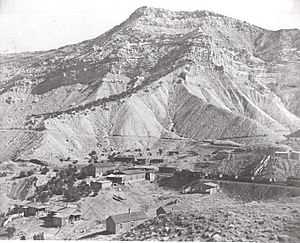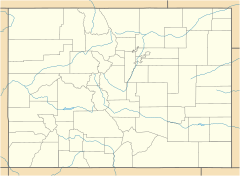Carpenter, Colorado facts for kids
Quick facts for kids
Carpenter, Colorado
|
|
|---|---|

Carpenter, ca. 1895. Grand Valley Mine tipple for loading coal into gondolas of the Little Book Cliff Railway
|
|
| Elevation | 1,770 m (5,810 ft) |
Carpenter was once a busy coal mining town in Mesa County, Colorado, United States. Today, it is a ghost town, meaning it is no longer inhabited. It is located about 12 miles (19.3 km) northeast of Grand Junction. The townsite sits at an elevation of about 5,808 feet (1,770 meters). A post office for Carpenter was open for a short time, from June 1890 to August 1891.
Contents
The Early Days of Carpenter
Building a Mining Town
Carpenter was founded in early 1890 by a man named William Thomas Carpenter. He wanted to create a place for the miners working in his two Book Cliff mines to live. At first, he built simple shacks for single miners. Later, he added small houses for families.
A Short-Lived Post Office
The town grew quickly, and in June 1890, a request was made for a U.S. post office. The request was approved, and the community was officially named Carpenter. However, the town never had more than 50 people living there. Because of its small size, the post office closed just one year later, in August 1891.
Community Buildings and Stone Work
After the post office closed, Carpenter built a company store. He also added a building that served as both a boarding house and a restaurant. Skilled stone cutters and masons from the Book Cliff company helped build several structures. They used stone from a nearby quarry. A beautiful example of their work is the Catholic church in Fruita, Colorado.
Growth and Big Dreams
The Arrival of the Railway
The town saw several years of success after 1892. This was when the Little Book Cliff Railway reached Carpenter. William Carpenter then started to imagine grand plans for his small village.
A Resort That Never Was
Carpenter dreamed of turning his town into a tourist resort. He planned for a hotel, a dance hall, and picnic areas. He even wanted to create a lake fed by a spring near his mines. Carpenter renamed the camp Poland Spring, after a famous resort in Maine. People sometimes called it Polen, Pollen, or Polan Springs. He even put the name on his railroad cars. Sadly, these resort plans never came true. Carpenter lost all his money shortly after the Panic of 1893, a major economic downturn.
New Owners and Decline
Isaac Wyman Takes Over
After Carpenter went broke, Isaac Chauncey Wyman became the new owner. He was a rich investor from Massachusetts. The town continued to be active because Wyman worked to improve the mines. This created a need for more workers.
Changes Under Wyman
The old eating house, sometimes called the Hotel de Carpenter, was changed. It became a school and a church for the people living in the camp. Many company buildings were also rebuilt and improved during Wyman's time as owner. Wyman tried to rename the town "Book Cliff," but this name did not stick. People usually just called the place "the Book Cliff Mines."
The End of Carpenter
The town reached its busiest point and then slowly started to decline. This happened after Isaac Wyman passed away in 1910. In his will, Wyman left the town, the railroad, and the mines to Princeton University. Princeton managed everything for 15 years. However, in 1925, they decided to abandon it all. By the end of that summer, almost everything in Carpenter had been sold, taken apart, and moved away.


